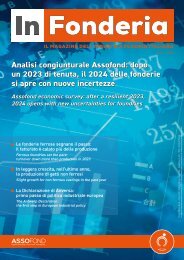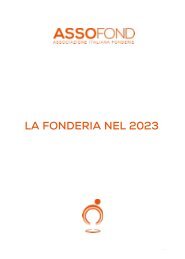In Fonderia 2 2024
Secondo numero del 2024 di In Fonderia
Secondo numero del 2024 di In Fonderia
You also want an ePaper? Increase the reach of your titles
YUMPU automatically turns print PDFs into web optimized ePapers that Google loves.
RUBRICHE<br />
personale addetto alla manutenzione ha difficoltà<br />
a identificare e risolvere i problemi prima che causino<br />
fermi macchina o danni alle apparecchiature.<br />
3. Il 98% dei siti non ha seguito le raccomandazioni<br />
del produttore in materia di manutenzione.<br />
Rispettare le raccomandazioni del produttore è<br />
fondamentale. Tuttavia, nella maggior parte degli<br />
impianti sottoposti ad audit ciò non è avvenuto.<br />
Questo può comportare:<br />
• <strong>In</strong>efficacia della garanzia, rendendo il proprietario<br />
dell’impianto responsabile di eventuali riparazioni<br />
o sostituzioni.<br />
• Un aumento della probabilità di guasti e un funzionamento<br />
non corretto dei dispositivi di protezione<br />
che potrebbe portare a un arresto.<br />
• Un’apparecchiatura poco efficiente comporta un<br />
aumento dei costi nell’impianto. <strong>In</strong> alcuni settori,<br />
come quello sanitario o alimentare, questo rende<br />
la struttura non conforme alle normative e alle<br />
linee guida che richiedono specifiche procedure<br />
manutentive.<br />
4. Il 79% ha utilizzato apparecchiature elettriche obsolete.<br />
Un’installazione elettrica tradizionale può avere<br />
più di 10 anni. A seconda di come è stata gestita,<br />
diversi dispositivi all’interno del sistema possono<br />
essere obsoleti, ovvero non più disponibili o riparabili.<br />
Se questi dispositivi rimangono operativi di solito<br />
non ci sono problemi evidenti. Ma cosa succede se<br />
si verifica un guasto? Gli operatori dell’impianto<br />
devono affrontare un aumento dei tempi di inattività,<br />
possibili rischi per la sicurezza e una riduzione<br />
dell’efficienza. Le apparecchiature elettriche<br />
obsolete sono inoltre incompatibili con la più moderna<br />
tecnologia in quanto limitano la possibilità<br />
di accedere alle funzioni digitali.<br />
5. Il 71% non ha i pezzi di ricambio per garantire la<br />
continuità del servizio.<br />
La maggior parte dei siti ha difficoltà a gestire il<br />
reperimento delle parti di ricambio. <strong>In</strong>dividuare il<br />
giusto inventario per garantire la continuità del<br />
servizio e rispondere alla criticità degli alimentatori<br />
può diventare presto un grattacapo. Senza<br />
contare che i tempi di produzione e di consegna di<br />
alcune apparecchiature possono ammontare a diverse<br />
settimane.<br />
Qualsiasi arresto può portare quindi a significative<br />
perdite non solo di produzione ma anche finanziarie<br />
in tempi molto brevi.<br />
Questi risultati mostrano le sfide che coloro che si occupano<br />
della manutenzione di un impianto elettrico<br />
devono affrontare. I servizi di gestione degli asset forniscono<br />
a gestori e proprietari una guida qualificata<br />
per la gestione e la manutenzione dei sistemi elettrici,<br />
garantendone la sicurezza e la massima efficienza. •<br />
problems before they cause downtime or damage<br />
to equipment.<br />
3 98% of sites did not follow the manufacturer’s<br />
maintenance recommendations.<br />
Following the manufacturer’s recommendations<br />
is crucial. However, this was not the case in most<br />
of the audited systems. This may result in:<br />
• <strong>In</strong>effectiveness of the warranty, making the<br />
plant owner liable for any repairs or replacements.<br />
• An increased likelihood of breakdowns and improper<br />
functioning of protective equipment that<br />
could lead to shutdowns.<br />
• <strong>In</strong>efficient equipment leads to increased costs in<br />
a system. <strong>In</strong> some sectors, such as healthcare or<br />
food, this makes the facility non-compliant with<br />
regulations and guidelines that require specific<br />
maintenance procedures.<br />
4. 79% used obsolete electrical equipment.<br />
A traditional electrical installation may well be<br />
more than 10 years old. Depending on how it has<br />
been operated, various devices within the system<br />
may be obsolete, i.e. no longer available or repairable.<br />
If these devices remain operational, there are<br />
usually no obvious problems. But what happens<br />
if a fault occurs? Plant operators face increased<br />
downtime, possible safety risks and reduced efficiency.<br />
Obsolete electrical equipment is also incompatible<br />
with the latest technology as it limits<br />
the ability to access digital functions.<br />
5. 71% do not have the spare parts to guarantee<br />
continuity of service.<br />
Most sites have difficulty managing the procurement<br />
of spare parts. Finding the right inventory to<br />
guarantee service continuity and respond to critical<br />
power supplies can quickly become a headache.<br />
Not to mention that production and delivery<br />
times for some equipment can amount to several<br />
weeks.<br />
Any stoppage can therefore lead to significant<br />
losses not only in production but also financial<br />
losses in a very short time.<br />
These results show the challenges faced by those<br />
involved in the maintenance of an electrical installation.<br />
Asset management services provide managers<br />
and owners with qualified guidance for the operation<br />
and maintenance of electrical systems, ensuring<br />
their safety and maximum efficiency. •<br />
<strong>In</strong> <strong>Fonderia</strong><br />
75














